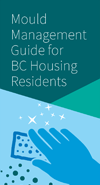Discover tips and resources for maintaining your property and enhancing the quality of your tenants' housing.
Maintenance Planning
Determining the amount of maintenance individual building components need is the goal of maintenance planning. Here are some common categories for you to consider:
- Regular maintenance – All building components can last longer if you have a preventative maintenance plan in place.
- Safety of your tenants – Make sure that your property and building is free of hazards. Take care of any problems right away.
- Regular inspections – Spot small problems and take care of them before they become big and expensive.
Regular unit inspections – Plan for future repairs and take care of any immediate repairs that are needed without delay.
Common Issues
Bed bugs
Bed bug infestation is a major problem for tenants and operators. Health and mental well-being can be seriously affected by prolonged exposure to bed bugs and other insects, such as cockroaches and mites. Low-barrier and hard-to-house facilities are more vulnerable to infestation.
Bed bugs can be difficult to eradicate once they appear. View the Bed Bug Information for Emergency Shelters fact sheet for general advice for managing a bed bug infestation.
Bed bug treatment options
There are a variety of different methods to eradicate bed bugs, including:
- Chemical sprays
- Steam
- Cold treatment
- Heat treatment (including both portable and heat treatment rooms)
- Diatomaceous earth
Talk to a local pest control provider to determine the best methods for each situation.
Mould management
Mould is a fact of life. Moulds will grow practically everywhere people live and work. Mould is recognized as an occupational hazard for indoor workers as well as outdoor workers who work in warm and humid environments. All moulds are not harmful. However, certain types of moulds can cause adverse health effects.
You can read more information on mould management in Chapter 6.3 of the Housing Provider Guide for a Contractor Safety Program.
Our Mould Management Guide - Brochure is a helpful resource that provides tips on cleaning mould from many areas of the home.

Learn more about:
- How to find out if you have mould in your home
- How to report leaks and mould in your home
- How to prevent mould from occurring
- What to do if you suspect or have mould
- How to clean up small areas of mould
The following table highlights some of the common components that need maintenance in today’s more complex buildings.
| Building System | Action | Frequency |
|---|---|---|
| Building controls | Review any programmed controls or time clocks to ensure they’re working properly | Monthly |
| Common cleaning products | Consider using only environmentally friendly cleaning products | Green Seal labels | Always |
| Domestic hot water |
|
Annually |
|
Heating, ventilation and air conditioning (HVAC) |
|
Quarterly |
| Heating, ventilation and air conditioning (HVAC) |
|
Annually |
| Laundry |
|
Semi-annually |
| Laundry |
|
Daily |
| Lighting |
|
As-needed |
| Plug loads |
|
Always |
| Renewable energy |
|
Quarterly |
| Replacement product selection |
|
As-needed |
| Water |
|
As-needed |